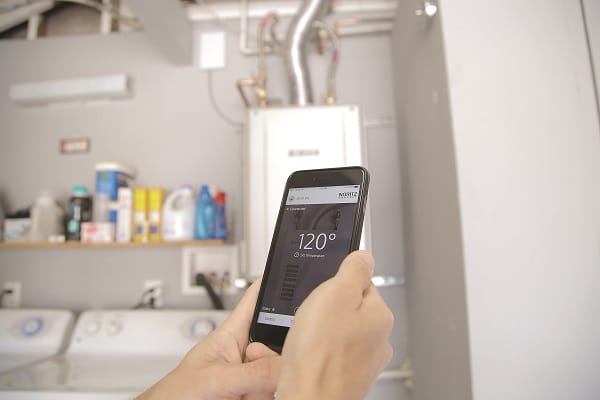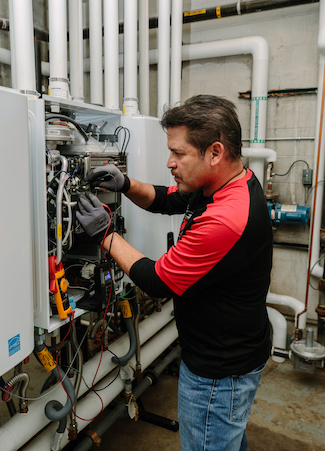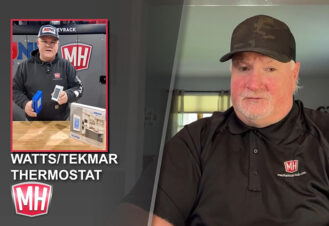Three considerations for right-sized tankless installations–and increased customer satisfaction
Propane tankless water heaters use less energy, cost less to operate, and produce fewer emissions than other options, which is why a growing number of homeowners are requesting these systems.
As contractors know, determining the right configuration for their projects isn’t always straightforward. Whether considering a single unit for the whole home or multiples that run in tandem, knowing how to predict demand is key to giving customers a setup that meets their performance and cost expectations.
Here are three factors to consider when right-sizing a tankless system for projects.

How much water will the customer need?
Knowing how many people will live in the home, who will be using hot water, and for what purposes is the first step toward installing a system that will fulfill their specific needs. Additionally, understanding a customer’s lifestyle and habits–when they shower, how often they do laundry, and whether they expect to install radiant heating–can help determine expected peak demand times.
Take stock of the number and type of appliances and systems requiring hot water and note their water delivery rates. To calculate peak demand, the Department of Energy (DOE) recommends counting the number and gallons per minute (GPM) rate of faucets, showers, and appliances that could be in use in the home at any given time. Features such as in-floor radiant heating and spas can considerably raise a home’s hot water demands. Propane tankless water heaters provide an endless supply of hot water, averaging roughly 222 gallons per hour, compared with an average first-hour delivery rating of just 62 gallons per hour for electric storage tank models.
How much will the water need to be heated?
It’s important for contractors and installers to know the difference between outdoor ground temperatures and the desired indoor hot water temperature. That will reveal how much the water will need to heat and, therefore, how quickly the unit can deliver hot water.
For example, a typical shower head delivers 2.5 GPM, so a 9.4 GPM unit would run three to four showers depending on the inlet ground water temperature. According to the DOE, the average groundwater temperature across the U.S. is 50 degrees. In most cases, water should be heated to at least 120 degrees, so the home will need a tankless unit that can heat 2.5 GPM by 70 degrees. Lower flows can be heated to a bigger temperature rise and higher flows to a smaller temperature rise. Most propane or natural gas tankless water heaters on the market can handle a rate of 5 GPM at a 70-degree temperature rise. As fixtures are added, demand on the system increases and that 5 GPM rating can quickly get overwhelmed.
While a tankless unit will provide hot water almost instantly at the unit, the water still has to travel to the faucet, so location of the units is an important part of system design. Oftentimes, two smaller units, each placed closer to the end use site, can provide the project a higher level of satisfaction than one large or two smaller units installed in a single location. This also provides some redundancy if a unit or fixture needs to be serviced.

What can the home accommodate?
Peak demand scenarios are why contractors shouldn’t assume an undersized system will cover their client’s full range of needs. Oversizing isn’t as big of a concern with tankless systems. While oversizing a traditional tank water heater would result in significant wasted energy over the life of the unit, tankless units vary their flow rates based on demand and, therefore, having excess capacity doesn’t necessarily mean a tankless system is using more energy.
New projects can more easily accommodate tankless units at the point of use than existing homes, which are often designed for a central tank system–and may be better suited for one or more units installed in the basement. For most projects, one unit is sufficient. Multiple units may be used to handle larger loads or as homeowners scale up in the future as their hot water needs change. Because of the popularity and dependability of propane tankless water heaters, new products are available on the market that would allow customers to have “multiple” heaters in a single cabinet, or on a single rack that comes to the project ready for installation making system design easier still.
To determine the optimal number of tankless units for a home, help customers understand their consumption habits and how the system can be sized to meet their expectations. Determine peak demand and gauge actual usage and lifestyle habits. Then, compare prices for systems that meet those needs relative to a client’s budget. Put in as much capacity as those factors will allow to balance cost and comfort. By simply installing a propane system, customers will see optimal cost savings. That’s because propane tankless water heaters offer reduced energy costs, a lower total cost of ownership, and a longer service life compared with other options. Notably, propane tankless systems can reduce energy costs by up to 50 percent and eliminate standby energy loss from the tank.
To learn more about propane water heating systems, visit Propane.com/Water-Heating.
 Bryan Cordill the director of residential and commercial business development for the Propane Education & Research Council. He can be reached at bryan.cordill@propane.com.
Bryan Cordill the director of residential and commercial business development for the Propane Education & Research Council. He can be reached at bryan.cordill@propane.com.




Join the conversation: